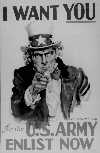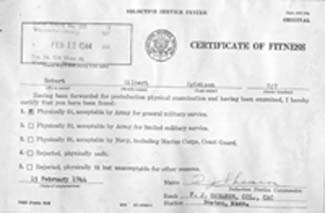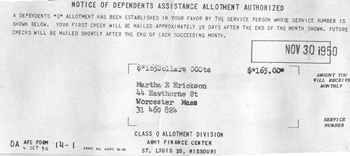 The
war profoundly impacted the homefront family structure. Wives, children,
and families were left without important members of their families. As
the draft broadened to include first married men, then to fathers, increasingly
families felt the war enter their homes. Husbands and wives feared "his
number being called." And sometimes it was. Eighteen percent of families,
almost one in five, contributed at least one member to the service. By
1945, there were 2,818,000 married men in the Army. Total, over 4 million
servicemen left wives and
The
war profoundly impacted the homefront family structure. Wives, children,
and families were left without important members of their families. As
the draft broadened to include first married men, then to fathers, increasingly
families felt the war enter their homes. Husbands and wives feared "his
number being called." And sometimes it was. Eighteen percent of families,
almost one in five, contributed at least one member to the service. By
1945, there were 2,818,000 married men in the Army. Total, over 4 million
servicemen left wives and  children
behind, without the head of their home, and often without the primary
source of income.(12) Families faced with
this situation in Quinsigamond reflect the different ways families across
the country handled the absence of a father, brother, or husband.
children
behind, without the head of their home, and often without the primary
source of income.(12) Families faced with
this situation in Quinsigamond reflect the different ways families across
the country handled the absence of a father, brother, or husband.
Quinsigamond represents a microcosm for national rationale for American
servicemen. Quinsigamond Village sent its share of men to the War. Men
went for different reasons. Some joined up after Pearl Harbor, others
were drafted away from their families. Attitudes towards service seemed
as varied as each soldier's story and each opinion structured by the individual's
circumstances. Evelyn
Grahn, whose husband was at home for the duration, believed that "most
went willing." However, Martha
Erickson's husband was drafted out of the Reserves, so her idea differs.
Martha explained, "They had to go, that's all. They were drafted."
For the men, their thoughts on enlisting depended on their family status.
Younger men like Vernon
Rudge recalled, "Everybody joined up, most people joined up.
At my age, in my group, they were going in." Edward
Steele, a married father, held a different view. "I didn't want
to go into the war, but I got drafted." 
Certainly, plenty of government and societal influence existed to help
these men make their decisions to enlist. Propaganda posters told them,
Uncle Sam needs you! Hollywood, as well, made men feel it was their duty
to go. In the movies, there was always an explanation if an actor was
not in uniform.(13) Norman
Burgoyne felt this pressure to enlist. He "couldn't see being
the only man around." Also, with the implimentation of the Selected
Training and Service Act, men who thought their number was coming up decided
it would be better to enlist and choose their branch. That was what prompted
Marge Dalhquist's brother
to enlist.
Others were not as eager to sign up. Men with wives, with young children,
or those with a duty to younger siblings did not want to abandon their
families. Olaf Rydstrom
worried about his family saying, "The government took care of
them. But, it must have been awful rugged. I worried about that, too."
Wives like Victoria Rydberg feared
their husbands would be called up. And yet, even in the face of fear and
hope of getting passed by, there is a tone of acceptance and of duty.
"All the fellas had to go," recalled Martha
Erickson. And even though families were devastated to see sons and
husbands go, they were proud to say their family served. Families like
the Ingmans hung
stars in the window to share that they had a serviceman in the family.
Florence remembered, "You were all so proud that you had a member
in your family that was serving the country."
But these missing men left great voids in the Quinsigamond community.
They left behind not only vacancies in the factories, but also empty places
at the kitchen table and pay checks that now came from the government.
These fighting fathers and sons created a change in family dynamic, had
profound influences on their children, and had economic impact on their
families.
Mothers now assumed many different roles. To help the "war wife,"
a plethora of advice circulated. So Your Husband's Gone to War!
by Ethel Gorham was "a practical handbook for the wives of the servicemen."
(14) This guide offered advice on everything
from budgeting to loneliness, from wartime diet to letter writing. Women
also received advice from the government in the form of "You're
Monthly Letter from the Army."
Women were told to use pictures, gifts, and activities to teach and remind
their children of their missing fathers. Both Martha
Erickson and Florence Ingman
employed this tactic to make sure their children did not forget their
fathers. This fear was very real for these women. Florence
Ingman's daughter was only five months old when her husband left for
the war. When he returned, she didn't know him.
Children of the war often witnessed their mother's tears. However, most
recall, as one girl from California did, "My mother was the real
hero in our lives." (15) Florence
Ingman recalled finding the strength she needed to keep her family
going. "We were hoping it wouldn't come to this [draft] but…I'm
one that can pick up the pieces."
The women of Quinsigamond had help in their mission to pick up the pieces.
Family and community created the support system these women fell back
on. In American Women in a World of War, Litoff and Smith report
the options for war wives. "With their husbands away in the service,
war wives almost always experienced a reduction in family income. In order
to make ends meet, they moved in with other war wives, took in borders,
returned to their childhood homes to live, and sometimes sought war work."(16)
Quinsigamond women provided examples of each of these trends.
Martha Erickson
relied heavily on her family, for support and for company. "We used
to go up to my mother's and she helped me a lot." Ruth
Burgoyne had established a rotation with other war wives where they
would take turns gathering at each other's homes. Florence
Ingman returned to her childhood home in Vermont. She no longer had
to pay rent and her mother took care of her child so she could work.
These women faced not only loneliness, but also an economic dilema. They
were now living on military dependents pay. Ruth
Burgoyne explained that she would have gotten more if her husband
was an officer. But, since he was a private, she only got $80 a month
and rent was $22.  In
the face of this economic hardship, I was surprised in the interviews
that many Quinsigamond women did not supplement soldiers' pay by
getting a job. Many did not answer the propaganda-enforced call for Rosie
the Riveters in Worcester's factories. Some, like Eleanor
Rudge did, and felt a sense of contribution. Others did not. The simple
reason they gave: children. Martha answered simply, "No, I couldn't
have a job with the little one. I didn't want to leave him alone. And
my mother lived on Burncoat St, so it was kinda far." Ruth
Burgoyne concurred. "None of my friends worked either. We all
had children, remember?" Their reason was reflective of a national
conversation during the war regarding working mothers and latchkey children.
(For more information about working women, click
here.)
In
the face of this economic hardship, I was surprised in the interviews
that many Quinsigamond women did not supplement soldiers' pay by
getting a job. Many did not answer the propaganda-enforced call for Rosie
the Riveters in Worcester's factories. Some, like Eleanor
Rudge did, and felt a sense of contribution. Others did not. The simple
reason they gave: children. Martha answered simply, "No, I couldn't
have a job with the little one. I didn't want to leave him alone. And
my mother lived on Burncoat St, so it was kinda far." Ruth
Burgoyne concurred. "None of my friends worked either. We all
had children, remember?" Their reason was reflective of a national
conversation during the war regarding working mothers and latchkey children.
(For more information about working women, click
here.)
It was not only the war wives and mothers who had to adapt to the missing
servicemen. Absent fathers had a tremendous impact on their children.
Most father-absent research has been done on boys, but clearly the entire
family was impacted. In a book called Children from Five to Ten,
a child's changing perception of the war is explored."Before age
five, the children had little comprehension of the subject, but at five
and six they devised plans for ending the war."(17)
Children also frequently played war games. Victoria
Rydberg's son encapsulated this description of a young homefront boy.
He told his mother, "I'm strong. I can go to war." But, the
limits of his understanding were revealed when he explained to his mother
that, without a doubt, he "would come back."
 Many
parents, especially fathers who were leaving, thought their young children
did not understand. Norman Burgoyne
was concerned about his children's perception of the war. He stated, "I
really don't know if they were really old enough to really understand
that there was even a war. All they knew was that their father wasn't
home." Olaf Rydstrom concurred
saying, "They were too little." However, as Olaf
Rydstrom's daughter Bev recalled, memories and pictures of their fathers
at war made lasting impacts. She recalled her father at the train saying,
"You looked sad, we looked sad. Because we knew that he was going
back." Children understood and perceived the danger and fear much
more than their parents thought.
Many
parents, especially fathers who were leaving, thought their young children
did not understand. Norman Burgoyne
was concerned about his children's perception of the war. He stated, "I
really don't know if they were really old enough to really understand
that there was even a war. All they knew was that their father wasn't
home." Olaf Rydstrom concurred
saying, "They were too little." However, as Olaf
Rydstrom's daughter Bev recalled, memories and pictures of their fathers
at war made lasting impacts. She recalled her father at the train saying,
"You looked sad, we looked sad. Because we knew that he was going
back." Children understood and perceived the danger and fear much
more than their parents thought.
Older children also experienced the war in school. Elementary school is
cited as an "impressionable time for children to be exposed to heavy
doses of patriotism and democratic ideology that prevailed on the homefront."
(18) And heavy doses were exactly what
American school children got. By 1948, forty-four states had laws requiring
"instruction on the Constituition" in elementary school. (19)
America had become fiercely patriotic and brought that tone to the schools
and subsequently to the children. As Penny
Copeland remembered, students and teachers would often pray for and
talk about members of the children's families who were abroad fighting.
Quinsigamond Village reflects very national concerns about fathers and
families during war time. First, these men tackled the difficult questions,
Should I enlist? What about my family? How will they manage if I am drafted?
Then, we can examine this community to learn about the various ways life
went on without these men and they impact their absence had. These same
issues were tackled throughout the nation. Quinsigamond Village responded
with a sense of community support for its residents. This kind of response
is what leads many of this generation to look back fondly on what were
truly very difficult times, and why we are told that they are the "greatest
generation."